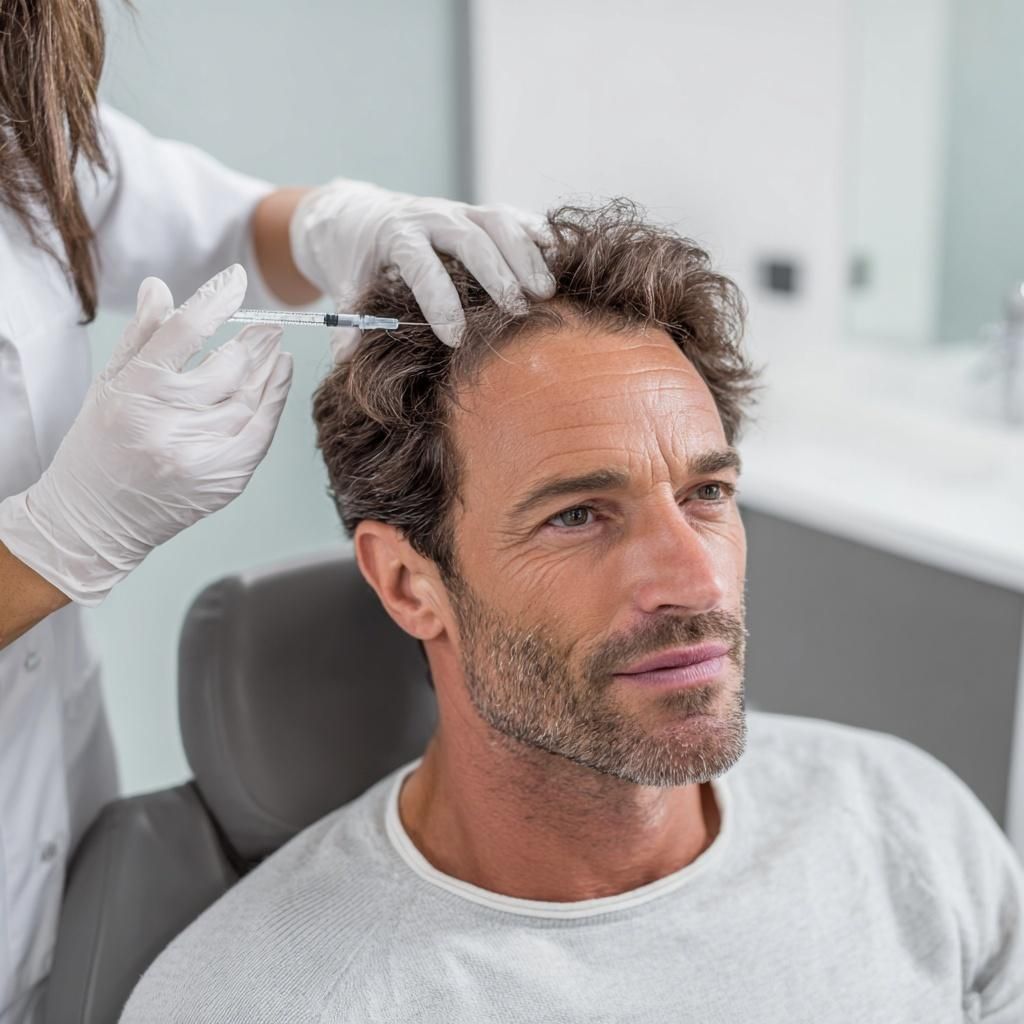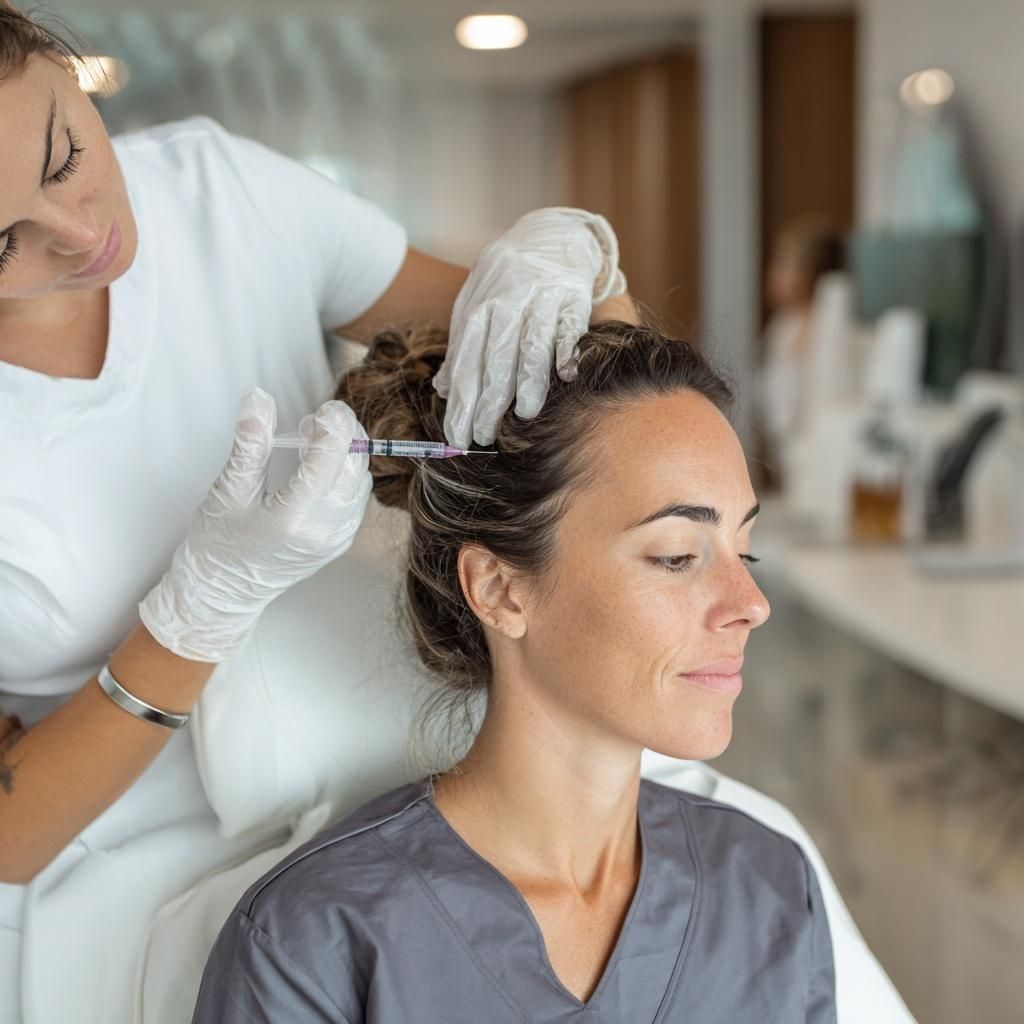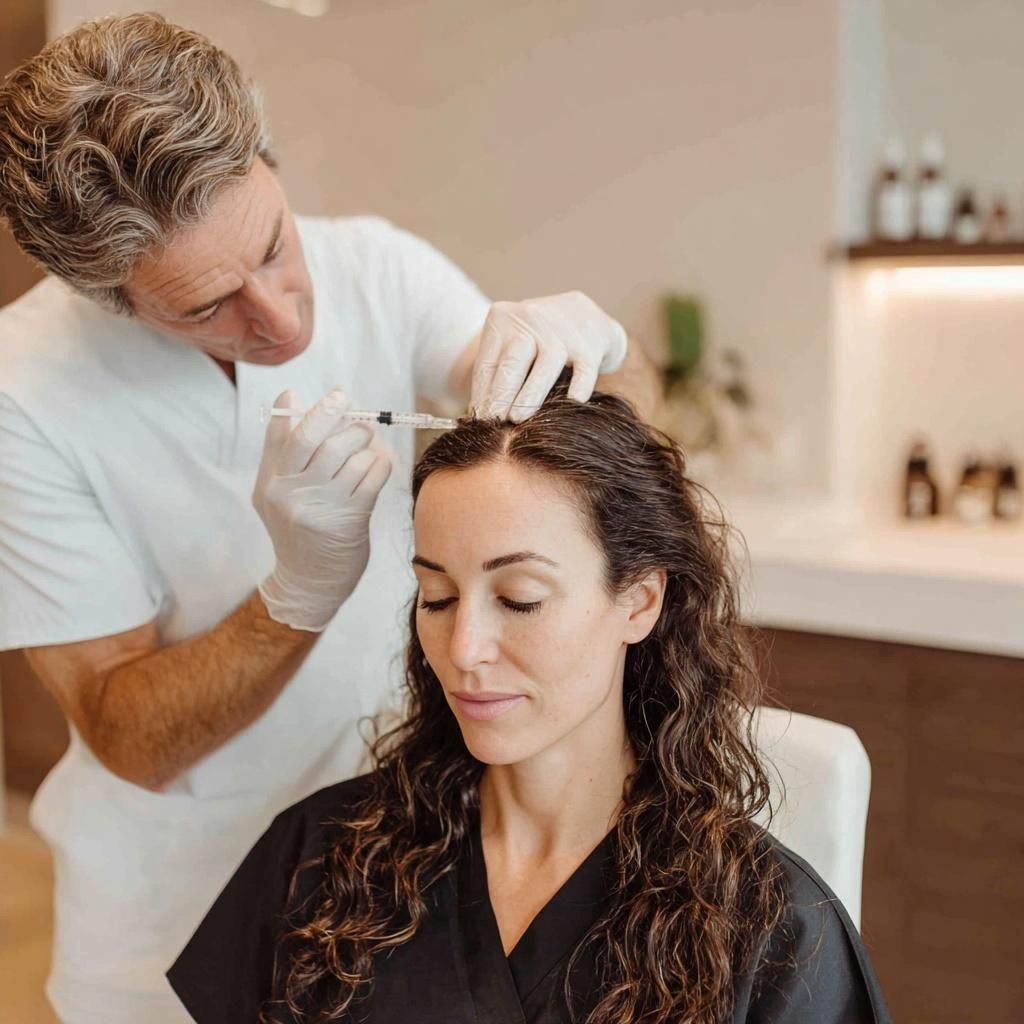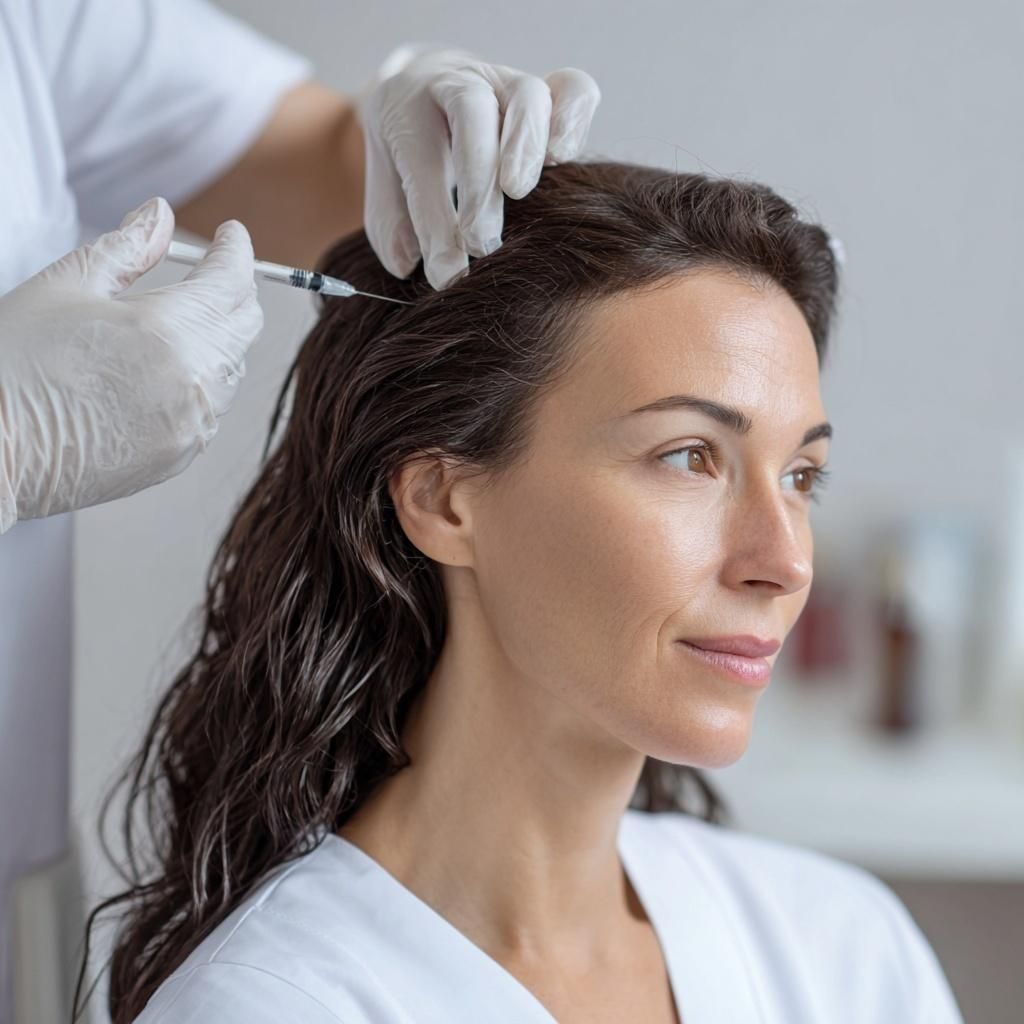PRP Hair Treatment in Grants Pass, OR – Regrow Hair Naturally

You’re standing in front of the mirror and your scalp is suddenly more visible than it used to be. Maybe you’re finding more hair in the shower drain. Or you’ve been avoiding certain hairstyles that once felt effortless. Hair loss isn’t just a cosmetic concern. It chips away at confidence and identity.
What if you could promote natural hair growth using your body’s own healing power?
That’s exactly what PRP therapy offers. At Southern Oregon Medical Aesthetics, PRP treatment for hair loss is helping people in Grants Pass restore fuller, thicker hair without surgery or medications. And it all starts with your blood.
What Is Platelet-Rich Plasma (PRP)?
Platelet-rich plasma is a concentrated portion of your own blood packed with platelets; tiny blood cells known for their role in healing. These platelets release growth factors that stimulate cell repair and tissue regeneration. In hair restoration, these same growth factors work to revive dormant hair follicles, improving hair thickness and density.
The PRP preparation process begins by drawing a small amount of your blood. This blood is then spun in a centrifuge to separate the red and white blood cells from the plasma rich in platelets. What’s left is the golden-colored PRP, which is then injected into areas of hair loss on the scalp.
Originally used in orthopedics and sports medicine, PRP is now widely used in cosmetic dermatology. Research shows PRP therapy may help patients with androgenetic alopecia, female pattern hair loss, and other forms of thinning hair without the need for surgery or synthetic medications.
How PRP Treatment Stimulates Hair Growth

When PRP is injected into your scalp, it sends signals to your hair follicles to start functioning again. The growth factors in PRP, such as vascular endothelial growth factor (VEGF), increase blood supply to the hair root, boost stem cell activity around the follicle, and kickstart the anagen (growth) phase of the hair cycle.
These effects of PRP can lead to:
- Increased hair density
- Thicker, healthier strands
- Extended hair growth cycles
- Reduced hair shedding
Compared to traditional hair loss treatments like minoxidil or finasteride, PRP does not rely on daily use or come with unwanted side effects. Many patients combine PRP with microneedling or other therapies to further stimulate hair regrowth.
Who Is a Good Candidate for PRP Hair Restoration?
PRP works best if you’re in the early stages of hair loss or dealing with thinning hair. Ideal candidates include:
- Men and women with male or female pattern baldness
- Patients with diffuse hair thinning
- Those who’ve experienced recent hair shedding due to stress or illness
PRP therapy is not effective for complete baldness or areas where the follicle has fully shut down. If you have scarring alopecia, PRP is unlikely to help. A thorough scalp evaluation will help determine whether PRP hair restoration is right for you.
The PRP Hair Treatment Process: What to Expect
Wondering what a typical PRP hair restoration journey looks like? Here’s a breakdown of each step (from consultation to aftercare) so you know exactly what to expect.
Step 1: Consultation and Scalp Evaluation
Every patient begins wondering what a typical PRP hair restoration journey looks like? Here’s a breakdown of each step (from consultation to aftercare) so you know exactly what to expect.
Step 2: The PRP Procedure
Here’s a step-by-step overview of what your visit might look like:
| Step | What Happens |
|---|---|
| Blood Draw | We draw a small amount (10–20 ml) of your blood. |
| Centrifuge Spin | Your blood is placed into a centrifuge to separate the PRP. |
| Injection Process | We use tiny needles to inject PRP into targeted areas of the scalp. |
| Post-Treatment Care | Mild tenderness may occur. You can return to normal activities right after. |
Step 3: Recovery and Aftercare
There’s no long recovery with PRP. Most patients report only mild redness or scalp sensitivity. You’ll need to avoid hot showers, alcohol, or caffeine for 24 hours after treatment. After that, you can wash your hair and return to your regular routine.
What Are the Benefits of PRP for Hair Loss?

There are many reasons patients in Grants Pass are choosing PRP for hair:
- It’s natural. The treatment uses your own platelets with no drugs or chemicals.
- No downtime. You can go back to work or social activities the same day.
- Improves hair thickness. Clinical studies show it can increase hair count and improve overall hair quality.
- Confidence boost. When your hair looks better, you feel better.
With consistent sessions and proper care, PRP therapy may help restore hair growth and slow down further loss.
Risks and Side Effects of PRP Injections
Before beginning treatment, it’s important to understand the possible side effects; most are mild, but knowing what to expect can help you feel more prepared and confident.
What You Should Know Before Starting Treatment
Like all medical procedures, PRP treatment involves some risks. Most are minor and temporary:
- Redness or swelling at the injection site
- Scalp tenderness
- Minor bruising
- Temporary shedding before new hair growth starts
Rare but potential complications can include infection or inflammation if not handled properly. At Southern Oregon Medical Aesthetics, we follow strict safety protocols and only use autologous platelet-rich plasma, which significantly reduces the chance of a reaction.
How Soon Will You See PRP Results?
You won’t walk out with new hair immediately, but results build over time. Most patients begin to notice new hair growth within 3–4 months after their initial treatment.
Here’s a typical timeline:
● 1–2 months: Reduced shedding
● 3–4 months: New hairs become visible
● 6+ months: Noticeable improvement in hair thickness and volume
Most treatment plans start with 3 PRP sessions, spaced 4–6 weeks apart, followed by maintenance every 6–12 months to preserve your results.
How PRP Compares to Other Hair Loss Treatments
PRP isn’t the only option for addressing hair loss. Here's how it compares to other popular treatments available today.
Topical and Oral Options
Minoxidil (Rogaine) and finasteride (Propecia) are FDA-approved for pattern hair loss, but they require daily use and may cause side effects. PRP therapy offers a drug-free option with fewer maintenance requirements and fewer risks.
Hair Transplant Surgery
A hair transplant relocates follicles from one part of the scalp to another. While effective, it’s costly, invasive, and requires weeks of recovery. PRP is not a replacement for transplants, but many use it before or after surgery to stimulate hair growth and enhance results.
Laser Therapy
Low-level laser devices promote blood flow to the scalp, but results are subtle and may take many months. PRP injections offer a targeted and concentrated solution that works with your natural biology.
Why Choose Southern Oregon Medical Aesthetics for PRP Hair Restoration in Grants Pass, OR

At Southern Oregon Medical Aesthetics, your care is in the hands of expert doctors and highly trained injectors who specialize in advanced aesthetic and regenerative treatments. We understand that hair loss can affect more than just your appearance; it impacts your confidence and quality of life.
That’s why we offer personalized PRP hair restoration plans using state-of-the-art techniques and equipment. Our team combines medical expertise with a patient-centered approach to ensure you receive safe, effective, and natural-looking results. When you choose us, you're choosing experience, precision, and a true commitment to helping you look and feel your best.
FAQs About PRP Hair Treatment
1. Does PRP regrow hair permanently?
PRP therapy may restore hair growth, but it’s not permanent. Maintenance treatments every 6–12 months are recommended to sustain results and keep hair follicles active.
2. Is PRP painful for hair loss?
Most patients describe the injections as mild discomfort, not pain. A topical numbing cream is applied beforehand to keep you comfortable.
3. Can I drink coffee after PRP treatment?
We recommend avoiding caffeine for 24 hours post-treatment. Caffeine can increase blood pressure and affect the healing environment of your scalp.
4. How do I heal faster after PRP?
Stay hydrated, eat whole foods, and avoid smoking or alcohol. Be gentle on your scalp for the first 48 hours. Follow any specific aftercare instructions from your provider.
5. Are there any major side effects of PRP for hair loss?
Side effects are rare and usually mild. These may include swelling, redness, or tenderness at the injection site. Always ensure PRP is administered by trained professionals.
Conclusion: PRP Treatment Can Help Regrow Hair Naturally
Hair thinning doesn’t mean your hair story is over. With PRP hair restoration, you have a safe, natural, and effective option to stimulate hair growth using your body’s own platelets.
At Southern Oregon Medical Aesthetics, we combine medical expertise with personalized care. Whether you're seeing the first signs of male pattern baldness, dealing with female pattern hair loss, or simply hoping for fuller hair, PRP may be your solution.
Book your consultation today and take the first step toward new hair growth and renewed confidence; naturally, right here in Grants Pass.

